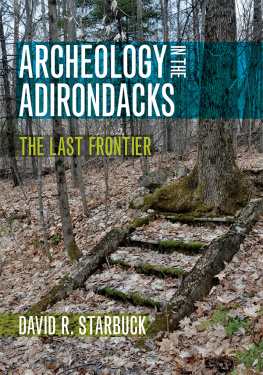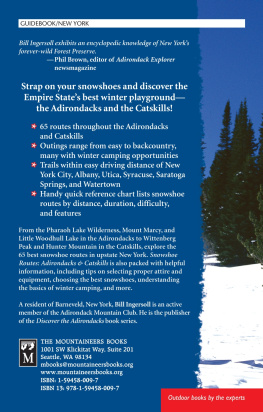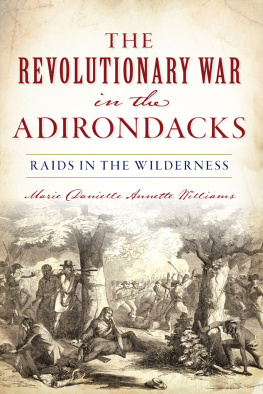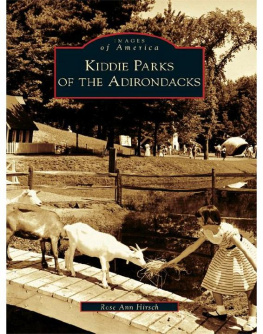
APPENDIX
Adirondack Attractions with Collections and Exhibits of Interest to Archeologists (in alphabetical order)
Adirondack Experience (formerly the Adirondack Museum)
9097 State Route 30, Blue Mountain Lake, NY 12812
(518) 352-7311
www.adirondackexperience.com
The Adirondack Experience in the hamlet of Blue Mountain Lake is a museum dedicated to preserving the history of the Adirondacks. Historic structures range from a log hotel to a one-room schoolhouse. The museum offers workshops on such topics as logging, boats, outdoor recreation, mining, craftsmanship, and fine arts.
Clinton County Historical Association and Museum
98 Ohio Road, Plattsburgh, NY 12903
(518) 561-0340
www.clintoncountyhistorical.org
The Clinton County Historical Association and Museum maintains a regionally and nationally significant collection of more than thirty thousand objects, including prints, photographs, paintings, folk art, textiles, furniture, musical instruments, letters, diaries, posters, jewelry, agricultural equipment, maps, postcards, ephemera, documents, and rare reference books.
Crown Point State Historic Site
21 Grandview Drive, Crown Point, NY 12928
(518) 597-4667
Crown Point State Historic Site is the location of the French-built Fort Saint-Frdric (17341759) as well as the British-built fort (commenced in 1759). The ruins of both forts are operated as a historic attraction by the State of New York.
Fort Ticonderoga
102 Fort Ti Road, Ticonderoga, NY
(518) 585-2821
www.fortticonderoga.org
Fort Ticonderoga, earlier known as Fort Carillon, is a large eighteenth-century star fort built by the French at a narrows near the south end of Lake Champlain. It was constructed under the supervision of Canadian-born French military engineer Michel Chartier de Lotbinire, Marquis de Lotbinire, between October 1755 and 1757. It was of strategic importance during the eighteenth-century colonial conflicts between Great Britain and France, and again played an important role during the American Revolutionary War.
Fort William Henry
48 Canada Street, Lake George, NY
(518) 964-6647
www.fwhmuseum.com
Fort William Henry was a British fort at the southern end of Lake George. It is best known as the site of atrocities committed against the surrendered British and provincial troops following a successful French siege in 1757, an event portrayed in James Fenimore Coopers novel The Last of the Mohicans, first published in 1826. The fort was first excavated and then reconstructed in the 1950s.
Goodsell Museum
2993 State Route 28, Old Forge, NY 13420
(315) 369-3838
www.webbhistory.org
The Goodsell Museum features six rooms of continually changing exhibits, artifacts, photographs, and memorabilia of early life in the Adirondacks.
Great Camp Sagamore
Sagamore Road, Raquette Lake, NY 13436
(315) 354-5311
www.sagamore.org
For more than fifty years, Sagamore served as the summer retreat of the Alfred G. Vanderbilt family. Today Sagamore is the only Great Camp operating as a nonprofit organization. It is open to the public for tours.
Jane McCreas Grave
Union Cemetery, 8 Schuyler Street, Hudson Falls, NY 12828
Union Cemetery opened for burials in 1847. It was officially named The Sandy Hill and Fort Edward Union Cemetery and is the primary burying ground for the villages of Hudson Falls and Fort Edward. It contains the well-known gravesites of Jane McCrea, murdered in 1777, and Duncan Campbell of the Black Watch.
Lake George Battlefield Park
Fort George Road (office is 139 Beach Road, Lake George, NY 12845)
(518) 668-3352
This thirty-five-acre park was the setting for the battle of Lake George in 1755. Historic monuments include a statue of Father Isaac Jogues, the first European man to have seen Lake George; a bronze sculpture of a Native American; a monument dedicated to General William Johnson and King Hendrick of the Mohawks. This also contains the remains of the southwest bastion of Fort George, commenced in 1759.
Lake George Historical Association
290 Canada Street, Lake George, NY 12845
(518) 668-5044
The Lake George Historical Association (LGHA) is a not-for-profit organization dedicated to the preservation of the history of the Lake George region. Located in the Historic Warren County Court House at Canada and Amherst Streets in Lake George Village, this 1845 brick structure is home for the Lake George Historical Association and its collection of artifacts.
North Star Underground Railroad Museum in Keeseville
634 Route 373, Keeseville, NY 12944
(518) 834-9990
The Underground Railroad helped tens of thousands of slaves escape to freedom before the Civil War, and thousands came through the Lake Champlain corridor to Canada. This museum brings to life that struggle for freedom as it played out in the Lake Champlain / Adirondack region.
Penfield Homestead Museum
703 Creek Road, Crown Point, NY 12928
(518) 597-3804
www.penfieldmuseum.org
The central feature of Penfield Homestead Museum is the ca. 1825 Penfield Homestead, which features first-floor rooms that depict early nineteenth-century life, including a formal parlor, mining business office, main kitchen, and summer kitchen. The first floor also features displays on Crown Point history. The second floor includes three bedrooms, a clothing and toy room, and a hallway and room dedicated to Crown Points involvement in the Civil War. A replica of Joseph Henrys electro-magnet is the highlight of the woodshed tour. It was the partnership between Allen Penfield, original builder of this homestead and iron industry pioneer, and Joseph Henry, inventor of the electro-magnet and first secretary of the Smithsonian, that gave rise to the Birthplace of the Electrical Age. The museum also boasts two walking trails, one of which is a walk back in time through the Crown Point Iron Company manufacturing complex.
The Wild Center
45 Museum Drive, Tupper Lake, NY 12986 (518) 359-7800 www.wildcenter.org
The Wild Center is a natural history center at Tupper Lake, near the center of the Adirondack Park. There are five primary indoor exhibit areas on the eighty-one-acre campus. The center features live exhibits and live animals, including river otters, birds, amphibians, and fish.
FURTHER READING
Abel, Timothy J. 2015a. Finding Cantonment Saranac: The Search for Col. Zebulon Pikes 18121813 Winter Cantonment in Plattsburgh, New York. Northeast Historical Archaeology 44:147161.
. 2015b. Storrs Harbor: Archaeology of a War of 1812 Naval Shipyard on Lake Ontario. Bulletin, Journal of the New York State Archaeological Association 129:1935.
. 2016. I Wish You Could See the Style in Which We Live: Archaeology of a Soldiers Cabin at Cantonment Saranac, Plattsburgh, New York. In Archaeology of the War of 1812, edited by Michael T. Lucas and Julie M. Schablitsky, 5774. New York: Routledge.
Adamson, Lisa, ed. 2017. Native American Presence, Lake George: Ancestral Lands and Voices, Lost, Reclaimed. Lake George Historical Association.
Allen, Ross F., James C. Dawson, Morris F. Glenn, Robert B. Gordon, David J. Killick, and Richard W. Ward. 1990. An Archeological Survey of Bloomery Forges in the Adirondacks. IA, the Journal of the Society for Industrial Archeology 16(1): 320.
Baker, Brenda J., and Christina B. Rieth. 2000. Beyond the Massacre: Historic and Prehistoric Activity at Fort William Henry. Northeast Anthropology 60:4561.
Barlow, Ronald S. 1992. The Vanishing American Outhouse. El Cajon, CA: Windmill.
Bellico, Russell P. 1992.
Next page










